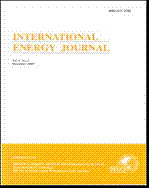ThaiScience
ThaiScience
INTERNATIONAL ENERGY JOURNAL
Volume 20, No. 02A, Month AUGUST, Year 2020, Pages 291 - 298
Comparison method of pso and de optimization for mppt in pv systems under partial shading conditions
Neethu Neethu M., R. Senthilkumar
Abstract Download PDF
Solar power is the conversion of energy from sunlight into electricity by using photovoltaic cell. The output power of the PV array decreases due to partial shading conditions such as clouds, trees, buildings, etc. There are a variety of traditional methods are available for tracking maximum power point. But these all techniques perform well only in uniform irradiation conditions, however during partial shaded conditions; these are not capable to search the global maximum power point. Therefore, there is a proper optimization technique is essential for maximum power point tracking in PV system under partial shading condition. In this paper we will evaluate the performance of PSO and DE algorithms for maximum power point tracking in partially shaded condition with a PV panel connected to load via CUK converter is verified on MATLAB/Simulink environment. The simulation results shows that the two techniques defeat the partial shading problems extremely well with a maximum output power and the DE method has advantages compare to PSO method. From this comparison it is observed that faster convergence is achieved in DE algorithm when compared to PSO algorithm.
Keywords
differential evolution algorithm, maximum power point tracking, partial shading condition, particle swarm optimization, photovoltaic.INTERNATIONAL ENERGY JOURNAL
Published by : Asian Institute of Technology
Contributions welcome at : http://www.rericjournal.ait.ac.th
